Abstract
Periodontal diseases are infections of the tissues supporting the dentition. Recognition that relatively specific microfloras are associated with distinct clinical forms of periodontal disease has prompted the use of antimicrobial agents as adjuncts in periodontal therapy. Clindamycin is one of several antibiotics known to concentrate in bioactive form in neutrophils and to potentiate phagocyte bactericidal activity against certain bacteria. Neutrophils appear to play a key role in host defense against periodontopathic gram-negative bacteria. In the present study, we evaluated the effect of preincubation of neutrophils with therapeutically achievable concentrations of clindamycin upon subsequent in vitro bactericidal activity against three species of gram-negative periodontal bacteria, including Actinobacillus actinomycetemcomitans, Eikenella corrodens, and Capnocytophaga ochracea. In each instance, clindamycin neither enhanced nor inhibited the kinetics of bactericidal activity at low bacterium-neutrophil multiplicities. Further, this antibiotic had no demonstrable effect upon neutrophil bactericidal capacity, as assessed at bacterium-neutrophil ratios as high as 50:1. Our results indicate that clindamycin does not potentiate neutrophil bactericidal activity against the species of gram-negative periodontal organisms tested.
Full text
PDF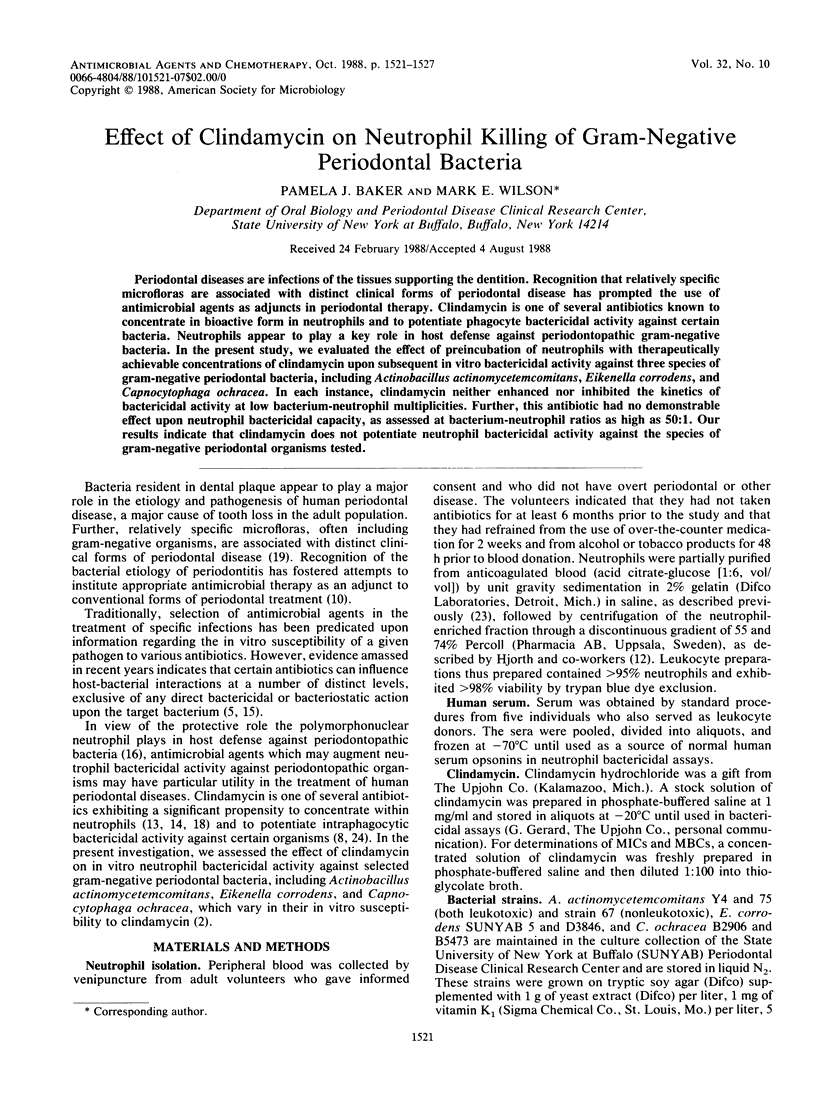
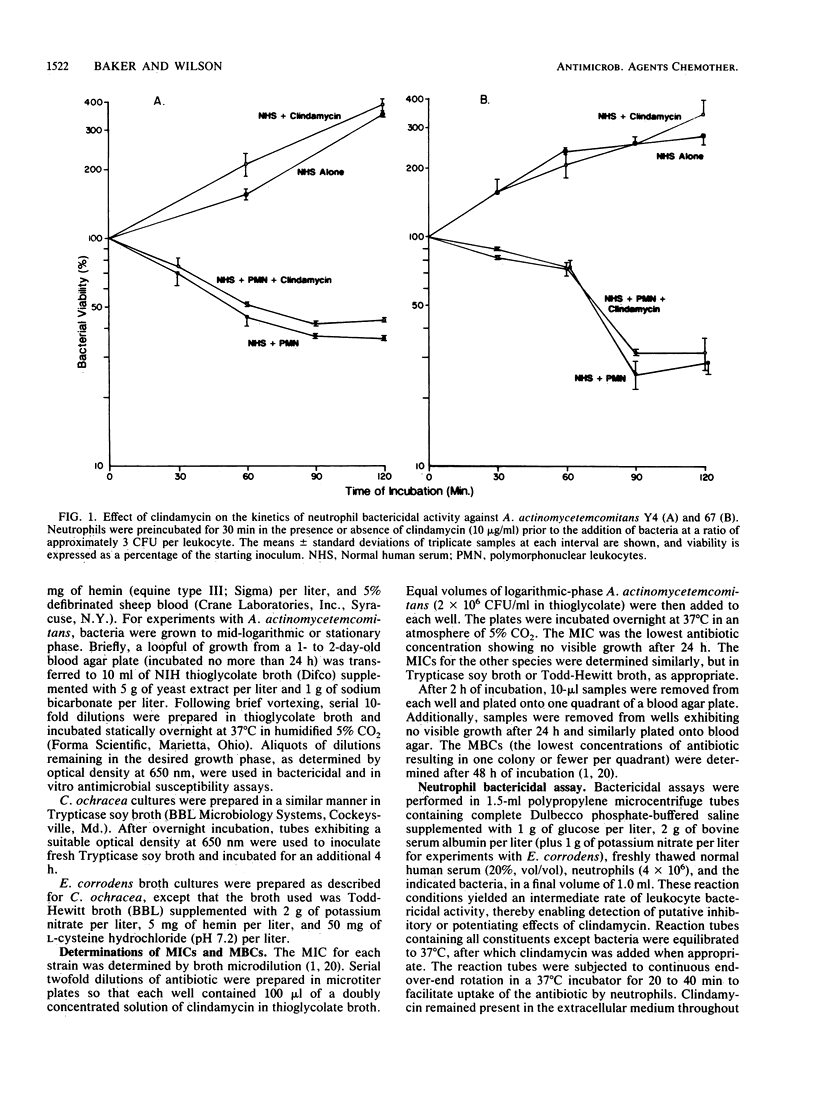
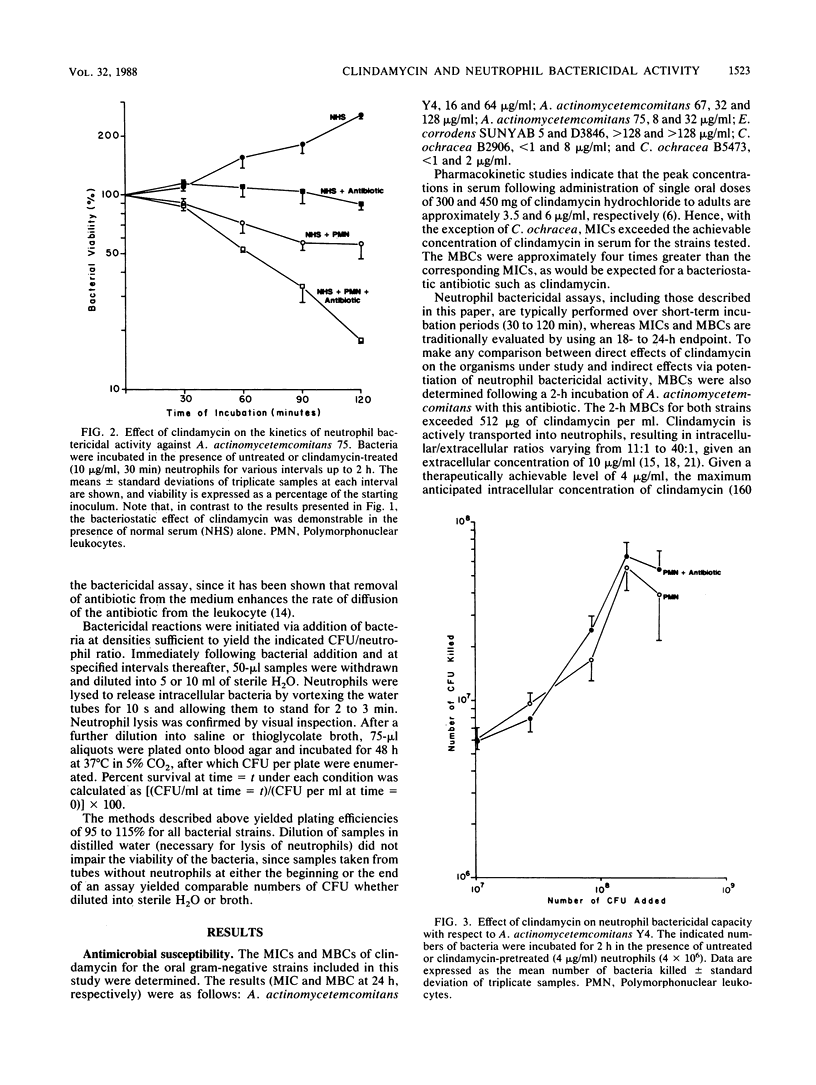
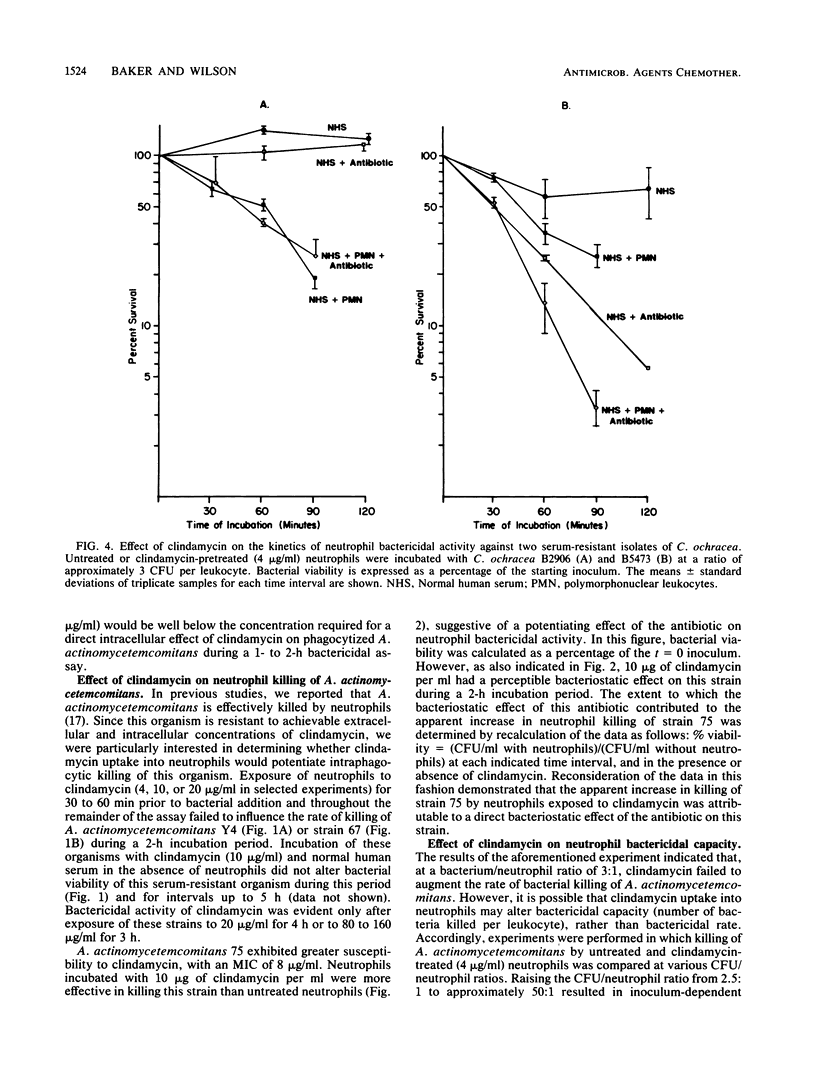
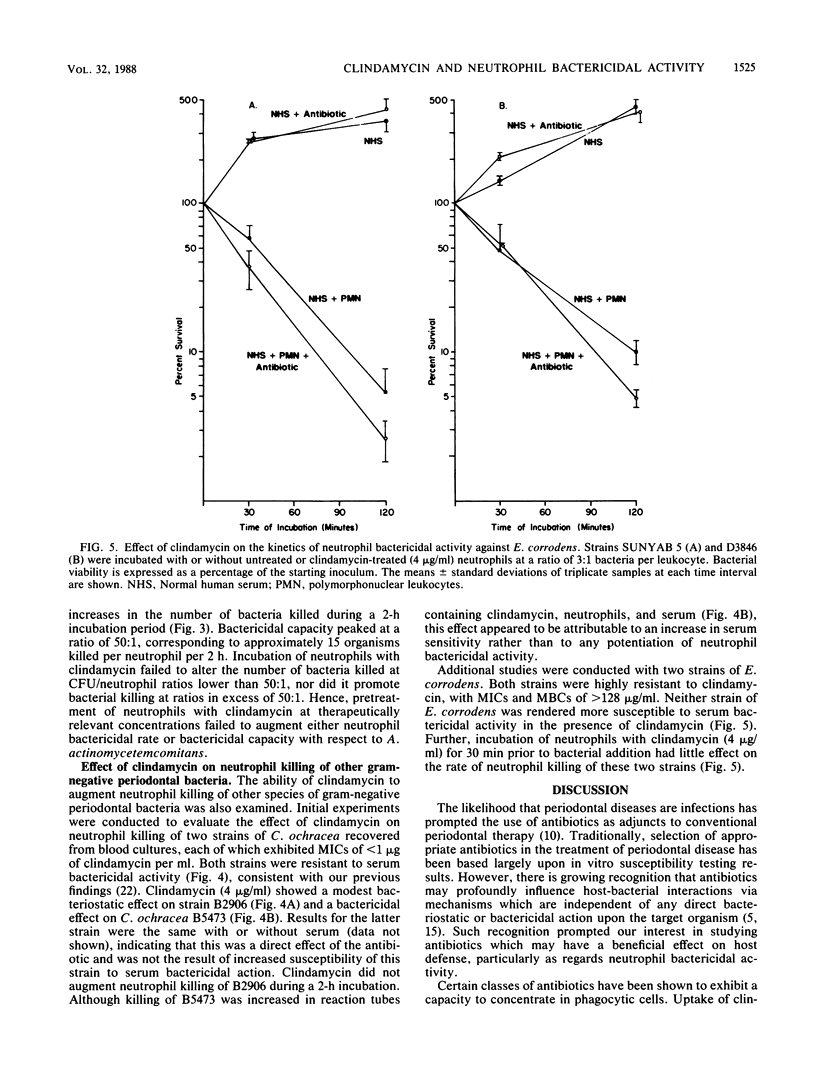
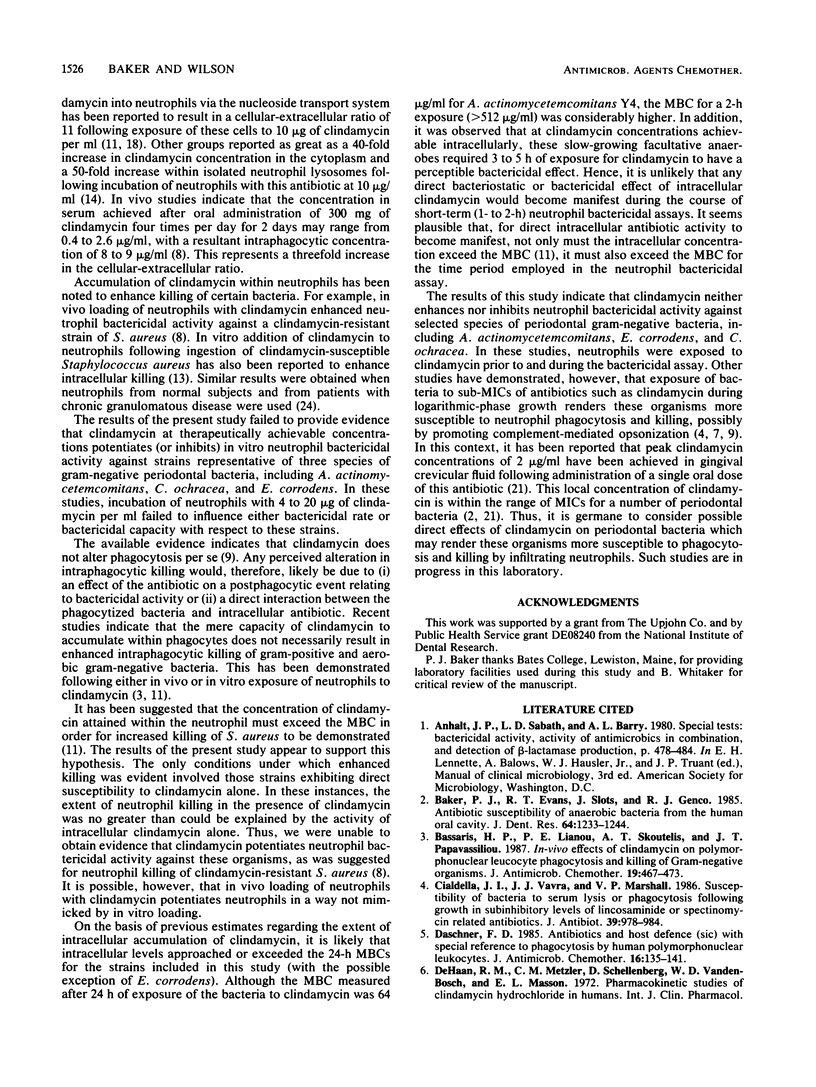
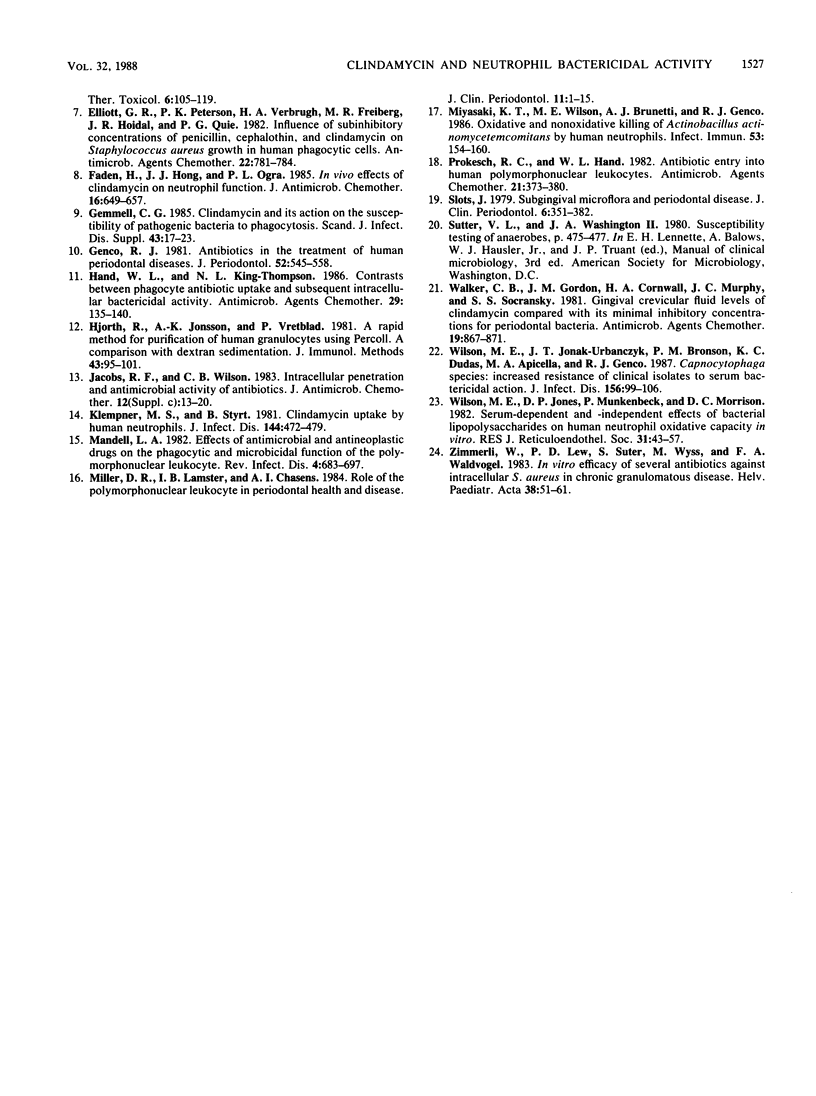
Selected References
These references are in PubMed. This may not be the complete list of references from this article.
- Baker P. J., Evans R. T., Slots J., Genco R. J. Antibiotic susceptibility of anaerobic bacteria from the human oral cavity. J Dent Res. 1985 Oct;64(10):1233–1244. doi: 10.1177/00220345850640101201. [DOI] [PubMed] [Google Scholar]
- Bassaris H. P., Lianou P. E., Skoutelis A. T., Papavassiliou J. T. In-vivo effects of clindamycin on polymorphonuclear leucocyte phagocytosis and killing of gram-negative organisms. J Antimicrob Chemother. 1987 Apr;19(4):467–473. doi: 10.1093/jac/19.4.467. [DOI] [PubMed] [Google Scholar]
- Cialdella J. I., Vavra J. J., Marshall V. P. Susceptibility of bacteria to serum lysis or phagocytosis following growth in subinhibitory levels of lincosaminide or spectinomycin related antibiotics. J Antibiot (Tokyo) 1986 Jul;39(7):978–984. doi: 10.7164/antibiotics.39.978. [DOI] [PubMed] [Google Scholar]
- Daschner F. D. Antibiotics and host defence with special reference to phagocytosis by human polymorphonuclear leukocytes. J Antimicrob Chemother. 1985 Aug;16(2):135–141. doi: 10.1093/jac/16.2.135. [DOI] [PubMed] [Google Scholar]
- Elliott G. R., Peterson P. K., Verbrugh H. A., Freiberg M. R., Hoidal J. R., Quie P. G. Influence of subinhibitory concentrations of penicillin, cephalothin, and clindamycin on Staphylococcus aureus growth in human phagocytic cells. Antimicrob Agents Chemother. 1982 Nov;22(5):781–784. doi: 10.1128/aac.22.5.781. [DOI] [PMC free article] [PubMed] [Google Scholar]
- Faden H., Hong J. J., Ogra P. L. In-vivo effects of clindamycin on neutrophil function. J Antimicrob Chemother. 1985 Nov;16(5):649–657. doi: 10.1093/jac/16.5.649. [DOI] [PubMed] [Google Scholar]
- Gemmell C. G. Clindamycin and its action on the susceptibility of pathogenic bacteria to phagocytosis. Scand J Infect Dis Suppl. 1984;43:17–23. [PubMed] [Google Scholar]
- Genco R. J. Antibiotics in the treatment of human periodontal diseases. J Periodontol. 1981 Sep;52(9):545–558. doi: 10.1902/jop.1981.52.9.545. [DOI] [PubMed] [Google Scholar]
- Hand W. L., King-Thompson N. L. Contrasts between phagocyte antibiotic uptake and subsequent intracellular bactericidal activity. Antimicrob Agents Chemother. 1986 Jan;29(1):135–140. doi: 10.1128/aac.29.1.135. [DOI] [PMC free article] [PubMed] [Google Scholar]
- Hjorth R., Jonsson A. K., Vretblad P. A rapid method for purification of human granulocytes using percoll. A comparison with dextran sedimentation. J Immunol Methods. 1981;43(1):95–101. doi: 10.1016/0022-1759(81)90040-5. [DOI] [PubMed] [Google Scholar]
- Jacobs R. F., Wilson C. B. Intracellular penetration and antimicrobial activity of antibiotics. J Antimicrob Chemother. 1983 Oct;12 (Suppl 100):13–20. doi: 10.1093/jac/12.suppl_c.13. [DOI] [PubMed] [Google Scholar]
- Klempner M. S., Styrt B. Clindamycin uptake by human neutrophils. J Infect Dis. 1981 Nov;144(5):472–479. doi: 10.1093/infdis/144.5.472. [DOI] [PubMed] [Google Scholar]
- Mandell L. A. Effects of antimicrobial and antineoplastic drugs on the phagocytic and microbicidal function of the polymorphonuclear leukocyte. Rev Infect Dis. 1982 May-Jun;4(3):683–697. doi: 10.1093/clinids/4.3.683. [DOI] [PubMed] [Google Scholar]
- Miller D. R., Lamster I. B., Chasens A. I. Role of the polymorphonuclear leukocyte in periodontal health and disease. J Clin Periodontol. 1984 Jan;11(1):1–15. doi: 10.1111/j.1600-051x.1984.tb01303.x. [DOI] [PubMed] [Google Scholar]
- Miyasaki K. T., Wilson M. E., Brunetti A. J., Genco R. J. Oxidative and nonoxidative killing of Actinobacillus actinomycetemcomitans by human neutrophils. Infect Immun. 1986 Jul;53(1):154–160. doi: 10.1128/iai.53.1.154-160.1986. [DOI] [PMC free article] [PubMed] [Google Scholar]
- Prokesch R. C., Hand W. L. Antibiotic entry into human polymorphonuclear leukocytes. Antimicrob Agents Chemother. 1982 Mar;21(3):373–380. doi: 10.1128/aac.21.3.373. [DOI] [PMC free article] [PubMed] [Google Scholar]
- Slots J. Subgingival microflora and periodontal disease. J Clin Periodontol. 1979 Oct;6(5):351–382. doi: 10.1111/j.1600-051x.1979.tb01935.x. [DOI] [PubMed] [Google Scholar]
- Walker C. B., Gordon J. M., Cornwall H. A., Murphy J. C., Socransky S. S. Gingival crevicular fluid levels of clindamycin compared with its minimal inhibitory concentrations for periodontal bacteria. Antimicrob Agents Chemother. 1981 May;19(5):867–871. doi: 10.1128/aac.19.5.867. [DOI] [PMC free article] [PubMed] [Google Scholar]
- Wilson M. E., Jonak-Urbanczyk J. T., Bronson P. M., Dudas K. C., Apicella M. A., Genco R. J. Capnocytophaga species: increased resistance of clinical isolates to serum bactericidal action. J Infect Dis. 1987 Jul;156(1):99–106. doi: 10.1093/infdis/156.1.99. [DOI] [PubMed] [Google Scholar]
- Wilson M. E., Jones D. P., Munkenbeck P., Morrison D. C. Serum-dependent and -independent effects of bacterial lipopolysaccharides on human neutrophil oxidative capacity in vitro. J Reticuloendothel Soc. 1982 Jan;31(1):43–57. [PubMed] [Google Scholar]
- Zimmerli W., Lew P. D., Suter S., Wyss M., Waldvogel F. A. In vitro efficacy of several antibiotics against intracellular S. aureus in chronic granulomatous disease. Helv Paediatr Acta. 1983 Mar;38(1):51–61. [PubMed] [Google Scholar]


